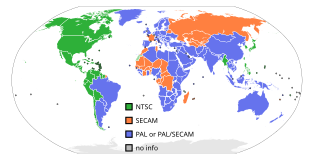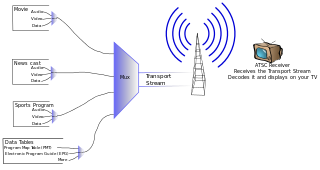Related Research Articles

NTSC is the first American standard for analog television, published and adopted in 1941. In 1961, it was assigned the designation System M. It is also known as EIA standard 170.

In telecommunications, orthogonal frequency-division multiplexing (OFDM) is a type of digital transmission used in digital modulation for encoding digital (binary) data on multiple carrier frequencies. OFDM has developed into a popular scheme for wideband digital communication, used in applications such as digital television and audio broadcasting, DSL internet access, wireless networks, power line networks, and 4G/5G mobile communications.
8VSB is the modulation method used for broadcast in the ATSC digital television standard. ATSC and 8VSB modulation is used primarily in North America; in contrast, the DVB-T standard uses COFDM.
A broadcast range is the service area that a broadcast station or other transmission covers via radio waves. It is generally the area in which a station's signal strength is sufficient for most receivers to decode it. However, this also depends on interference from other stations.
DVB-T, short for Digital Video Broadcasting – Terrestrial, is the DVB European-based consortium standard for the broadcast transmission of digital terrestrial television that was first published in 1997 and first broadcast in Singapore in February 1998. This system transmits compressed digital audio, digital video and other data in an MPEG transport stream, using coded orthogonal frequency-division multiplexing modulation. It is also the format widely used worldwide for Electronic News Gathering for transmission of video and audio from a mobile newsgathering vehicle to a central receive point. It is also used in the US by Amateur television operators.

Advanced Television Systems Committee (ATSC) standards are an international set of standards for broadcast and digital television transmission over terrestrial, cable and satellite networks. It is largely a replacement for the analog NTSC standard — like that standard — is used mostly in the United States, Mexico, Canada, South Korea, Trinidad and Tobago. Several former NTSC users like Japan, have not used ATSC during their digital television transition, because they adopted other systems like ISDB developed by Japan and DVB developed in Europe, for example.
Broadcasttelevision systems are the encoding or formatting systems for the transmission and reception of terrestrial television signals.
A rake receiver is a radio receiver designed to counter the effects of multipath fading. It does this by using several "sub-receivers" called fingers, that is, several correlators each assigned to a different multipath component. Each finger independently decodes a single multipath component; at a later stage the contribution of all fingers are combined in order to make the most use of the different transmission characteristics of each transmission path. This could very well result in higher signal-to-noise ratio (or Eb/N0) in a multipath environment than in a "clean" environment.

A single-frequency network or SFN is a broadcast network where several transmitters simultaneously send the same signal over the same frequency channel.
MPEG transport stream or simply transport stream (TS) is a standard digital container format for transmission and storage of audio, video, and Program and System Information Protocol (PSIP) data. It is used in broadcast systems such as DVB, ATSC and IPTV.

MediaFLO was a technology developed by Qualcomm for transmitting audio, video and data to portable devices such as mobile phones and personal televisions, used for mobile television. In the United States, the service powered by this technology was branded as FLO TV.

An ATSCtuner, often called an ATSC receiver or HDTV tuner, is a type of television tuner that allows reception of digital television (DTV) television channels that use ATSC standards, as transmitted by television stations in North America, parts of Central America, and South Korea. Such tuners are usually integrated into a television set, VCR, digital video recorder (DVR), or set-top box which provides audio/video output connectors of various types.
Mobile television is television watched on a small handheld or mobile device, typically developed for that purpose. It includes service delivered via mobile phone networks, received free-to-air via terrestrial television stations, or via satellite broadcast. Regular broadcast standards or special mobile TV transmission formats can be used. Additional features include downloading TV programs and podcasts from the Internet and storing programming for later viewing.

In telecommunications, the (digital) cliff effect or brick-wall effect is a sudden loss of digital signal reception. Unlike analog signals, which gradually fade when signal strength decreases or electromagnetic interference or multipath increases, a digital signal provides data which is either perfect or non-existent at the receiving end. It is named for a graph of reception quality versus signal quality, where the digital signal "falls off a cliff" instead of having a gradual rolloff. This is an example of an EXIT chart.
Audio-to-video synchronization refers to the relative timing of audio (sound) and video (image) parts during creation, post-production (mixing), transmission, reception and play-back processing. AV synchronization can be an issue in television, videoconferencing, or film.
E-VSB or Enhanced VSB is an optional enhancement to the original ATSC Standards that use the 8VSB modulation system used for transmission of digital television. It is intended for improving reception where signals are weaker, including fringe reception areas, and on portable devices such as handheld televisions or mobile phones. It does not cause problems to older receivers, but they cannot take advantage of its features. E-VSB was approved by the ATSC committee in 2004. However, it has been implemented by few stations or manufacturers.
ATSC-M/H is a U.S. standard for mobile digital TV that allows TV broadcasts to be received by mobile devices.
Time slicing is a technique used by the DVB-H and ATSC-M/H technologies for achieving power-savings on mobile terminal devices. It is based on the time-multiplexed transmission of different services.
In North American digital terrestrial television broadcasting, a distributed transmission system is a form of single-frequency network in which a single broadcast signal is fed via microwave, landline, or communications satellite to multiple synchronised terrestrial radio transmitter sites. The signal is then simultaneously broadcast on the same frequency in different overlapping portions of the same coverage area, effectively combining many small transmitters to generate a broadcast area rivalling that of one large transmitter or to fill gaps in coverage due to terrain or localized obstacles.
References
- Samsung Press Release, SAMSUNG's Advanced-VSB Technology To Bring Portable And Mobile TV To North American Digital TV Broadcasting , retrieved 2007-04-05, January 8, 2007.